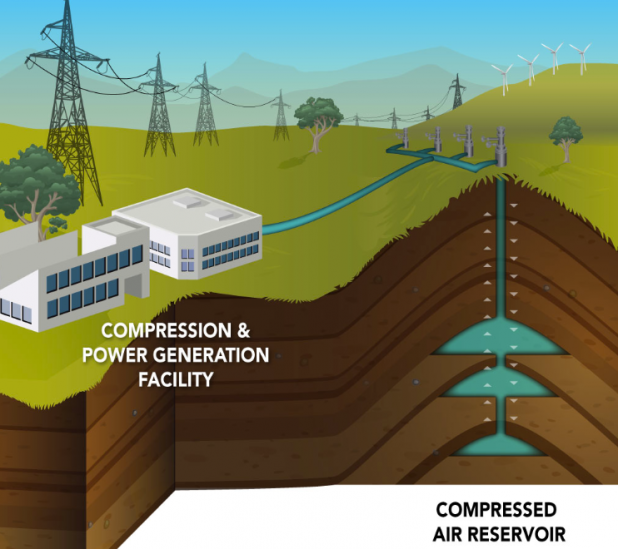[caption id="attachment_10794" align="aligncenter" width="501"]

Datacenters are notoriously power hungry.[/caption] Major IT vendors have been including custom-built wind- and solar-power farms in their datacenter construction plans. In addition to providing clean energy, these facilities bring in plenty of good publicity for Google, Apple, and other companies. Wind and solar power may be clean, but they're often unreliable, especially by the standards of datacenters that need a way to compensate for any unexpected surges or drops in power. Battery- and fuel-cell storage or co-generating systems—such as the one Apple built for its massive North Carolina datacenter—can bridge the gap, but not as efficiently as finding ways to simultaneously use and store the power generated by wind turbines. It’s difficult—if not impossible—to save power currently in use. But how about saving the wind that generates the power? That might work, according to researchers at the federa
l Bonneville Power Administration
(BPA), and U.S. Department of Energy's Pacific Northwest National Laboratory. (Hat tip to
National Geographic for the link.)
A study published in February (PDF) outlined the potential benefit of pumping pressurized air into caverns deep underground as a way to store wind energy, then letting it out whenever demand spikes, or the wind drops, and the above-ground facilities need help spinning enough turbines to keep power levels steady. The technique, called
Compressed Air Energy Storage (CAES), isn't new. Existing CAES plants in Alabama and Huntorf, Germany (built in 1991 and 1978, respectively) store compressed air in underground salt caverns hollowed out by solution mining (pumping salt-saturated water out of concentrations of salt buried far underground and replacing it with fresh water). Solutions-mining groups are looking for ways to use more disused salt mines as air-energy storage facilities, but giant underground salt caverns aren't as common as giant underground caverns or concentrations of porous volcanic rock, according to BPA and the Pacific Northwest National Laboratory. Adapting the technique to datacenter use could take some work. To that end, the two agencies have identified, and are evaluating, sites in the Pacific Northwest that would be suitable for CAES underground reservoirs. The first, located in Washington's Columbia Hills, could—via existing CAES technology—store enough compressed air to generate a steady 207MW for 40 days of continuous usage, ultimately delivering 400 additional hours without adding any additional compressed air (depending on the efficiency of the storage and recovery systems, of course). Power generated from wind breaking from under Columbia Hills could cost as little as 6.4 cents per kilowatt-hour, which the agencies said is competitive with power from other sources in the region. The other facility, in Yakima Canyon near the Oregon-Washington border, would use a hybrid system in which a geothermal-generating plant would leverage heat from the underground storage area to power the CAES facility and add to its output. That method could generate a steady 83MW of power, which would cost approximately 11.8 cents per kilowatt-hour. The storage reservoir is at the Yakima Canyon site is larger than the Columbia Hills reservoir; it’s also so deep, at 10,000 feet, that air injected into it would be stored under much higher pressure as well. The cavern's resulting capacity would be so great that air pumped into it at a steady rate for a full year would take up only 20 percent of its capacity. Though CAES is barely on the radar of few utilities, datacenter operators or even mining companies, BPA and PNNL investigators expect the capacity would be far greater than the requirements of a single datacenter, or even the clusters of datacenters built to take advantage of power costs in the renewable-energy-rich Pacific Northwest. CAES facilities could come online with as little as 10 minutes notice, and deliver enough power to contribute significant amounts to regional power grids to cover daily and seasonal drops in capacity from temporarily wind-starved wind farms, as well as from drops in supply from hydroelectric plants caused by low levels in the Columbia River.
 Images: Bonneville Power Administration, PNNL
Images: Bonneville Power Administration, PNNL  Datacenters are notoriously power hungry.[/caption] Major IT vendors have been including custom-built wind- and solar-power farms in their datacenter construction plans. In addition to providing clean energy, these facilities bring in plenty of good publicity for Google, Apple, and other companies. Wind and solar power may be clean, but they're often unreliable, especially by the standards of datacenters that need a way to compensate for any unexpected surges or drops in power. Battery- and fuel-cell storage or co-generating systems—such as the one Apple built for its massive North Carolina datacenter—can bridge the gap, but not as efficiently as finding ways to simultaneously use and store the power generated by wind turbines. It’s difficult—if not impossible—to save power currently in use. But how about saving the wind that generates the power? That might work, according to researchers at the federal Bonneville Power Administration (BPA), and U.S. Department of Energy's Pacific Northwest National Laboratory. (Hat tip to National Geographic for the link.) A study published in February (PDF) outlined the potential benefit of pumping pressurized air into caverns deep underground as a way to store wind energy, then letting it out whenever demand spikes, or the wind drops, and the above-ground facilities need help spinning enough turbines to keep power levels steady. The technique, called Compressed Air Energy Storage (CAES), isn't new. Existing CAES plants in Alabama and Huntorf, Germany (built in 1991 and 1978, respectively) store compressed air in underground salt caverns hollowed out by solution mining (pumping salt-saturated water out of concentrations of salt buried far underground and replacing it with fresh water). Solutions-mining groups are looking for ways to use more disused salt mines as air-energy storage facilities, but giant underground salt caverns aren't as common as giant underground caverns or concentrations of porous volcanic rock, according to BPA and the Pacific Northwest National Laboratory. Adapting the technique to datacenter use could take some work. To that end, the two agencies have identified, and are evaluating, sites in the Pacific Northwest that would be suitable for CAES underground reservoirs. The first, located in Washington's Columbia Hills, could—via existing CAES technology—store enough compressed air to generate a steady 207MW for 40 days of continuous usage, ultimately delivering 400 additional hours without adding any additional compressed air (depending on the efficiency of the storage and recovery systems, of course). Power generated from wind breaking from under Columbia Hills could cost as little as 6.4 cents per kilowatt-hour, which the agencies said is competitive with power from other sources in the region. The other facility, in Yakima Canyon near the Oregon-Washington border, would use a hybrid system in which a geothermal-generating plant would leverage heat from the underground storage area to power the CAES facility and add to its output. That method could generate a steady 83MW of power, which would cost approximately 11.8 cents per kilowatt-hour. The storage reservoir is at the Yakima Canyon site is larger than the Columbia Hills reservoir; it’s also so deep, at 10,000 feet, that air injected into it would be stored under much higher pressure as well. The cavern's resulting capacity would be so great that air pumped into it at a steady rate for a full year would take up only 20 percent of its capacity. Though CAES is barely on the radar of few utilities, datacenter operators or even mining companies, BPA and PNNL investigators expect the capacity would be far greater than the requirements of a single datacenter, or even the clusters of datacenters built to take advantage of power costs in the renewable-energy-rich Pacific Northwest. CAES facilities could come online with as little as 10 minutes notice, and deliver enough power to contribute significant amounts to regional power grids to cover daily and seasonal drops in capacity from temporarily wind-starved wind farms, as well as from drops in supply from hydroelectric plants caused by low levels in the Columbia River.
Datacenters are notoriously power hungry.[/caption] Major IT vendors have been including custom-built wind- and solar-power farms in their datacenter construction plans. In addition to providing clean energy, these facilities bring in plenty of good publicity for Google, Apple, and other companies. Wind and solar power may be clean, but they're often unreliable, especially by the standards of datacenters that need a way to compensate for any unexpected surges or drops in power. Battery- and fuel-cell storage or co-generating systems—such as the one Apple built for its massive North Carolina datacenter—can bridge the gap, but not as efficiently as finding ways to simultaneously use and store the power generated by wind turbines. It’s difficult—if not impossible—to save power currently in use. But how about saving the wind that generates the power? That might work, according to researchers at the federal Bonneville Power Administration (BPA), and U.S. Department of Energy's Pacific Northwest National Laboratory. (Hat tip to National Geographic for the link.) A study published in February (PDF) outlined the potential benefit of pumping pressurized air into caverns deep underground as a way to store wind energy, then letting it out whenever demand spikes, or the wind drops, and the above-ground facilities need help spinning enough turbines to keep power levels steady. The technique, called Compressed Air Energy Storage (CAES), isn't new. Existing CAES plants in Alabama and Huntorf, Germany (built in 1991 and 1978, respectively) store compressed air in underground salt caverns hollowed out by solution mining (pumping salt-saturated water out of concentrations of salt buried far underground and replacing it with fresh water). Solutions-mining groups are looking for ways to use more disused salt mines as air-energy storage facilities, but giant underground salt caverns aren't as common as giant underground caverns or concentrations of porous volcanic rock, according to BPA and the Pacific Northwest National Laboratory. Adapting the technique to datacenter use could take some work. To that end, the two agencies have identified, and are evaluating, sites in the Pacific Northwest that would be suitable for CAES underground reservoirs. The first, located in Washington's Columbia Hills, could—via existing CAES technology—store enough compressed air to generate a steady 207MW for 40 days of continuous usage, ultimately delivering 400 additional hours without adding any additional compressed air (depending on the efficiency of the storage and recovery systems, of course). Power generated from wind breaking from under Columbia Hills could cost as little as 6.4 cents per kilowatt-hour, which the agencies said is competitive with power from other sources in the region. The other facility, in Yakima Canyon near the Oregon-Washington border, would use a hybrid system in which a geothermal-generating plant would leverage heat from the underground storage area to power the CAES facility and add to its output. That method could generate a steady 83MW of power, which would cost approximately 11.8 cents per kilowatt-hour. The storage reservoir is at the Yakima Canyon site is larger than the Columbia Hills reservoir; it’s also so deep, at 10,000 feet, that air injected into it would be stored under much higher pressure as well. The cavern's resulting capacity would be so great that air pumped into it at a steady rate for a full year would take up only 20 percent of its capacity. Though CAES is barely on the radar of few utilities, datacenter operators or even mining companies, BPA and PNNL investigators expect the capacity would be far greater than the requirements of a single datacenter, or even the clusters of datacenters built to take advantage of power costs in the renewable-energy-rich Pacific Northwest. CAES facilities could come online with as little as 10 minutes notice, and deliver enough power to contribute significant amounts to regional power grids to cover daily and seasonal drops in capacity from temporarily wind-starved wind farms, as well as from drops in supply from hydroelectric plants caused by low levels in the Columbia River.  Images: Bonneville Power Administration, PNNL
Images: Bonneville Power Administration, PNNL 